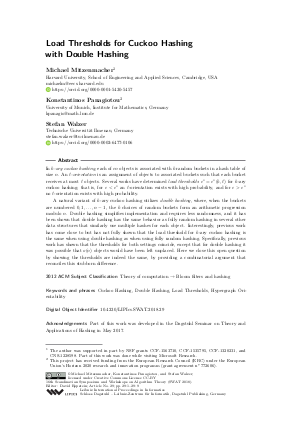Load Thresholds for Cuckoo Hashing with Double Hashing
Authors
Michael Mitzenmacher  ,
Konstantinos Panagiotou,
Stefan Walzer
,
Konstantinos Panagiotou,
Stefan Walzer 
-
Part of:
Volume:
16th Scandinavian Symposium and Workshops on Algorithm Theory (SWAT 2018)
Part of: Series: Leibniz International Proceedings in Informatics (LIPIcs)
Part of: Conference: Scandinavian Symposium and Workshops on Algorithm Theory (SWAT) - License:
 Creative Commons Attribution 3.0 Unported license
Creative Commons Attribution 3.0 Unported license
- Publication Date: 2018-06-04
File

PDF
LIPIcs.SWAT.2018.29.pdf
- Filesize: 0.53 MB
- 9 pages
Document Identifiers
Subject Classification
ACM Subject Classification
- Theory of computation → Bloom filters and hashing
Keywords
- Cuckoo Hashing
- Double Hashing
- Load Thresholds
- Hypergraph Orientability
Metrics
- Access Statistics
-
Total Accesses (updated on a weekly basis)
0Document
0Metadata
Abstract
In k-ary cuckoo hashing, each of cn objects is associated with k random buckets in a hash table of size n. An l-orientation is an assignment of objects to associated buckets such that each bucket receives at most l objects. Several works have determined load thresholds c^* = c^*(k,l) for k-ary cuckoo hashing; that is, for c < c^* an l-orientation exists with high probability, and for c > c^* no l-orientation exists with high probability. A natural variant of k-ary cuckoo hashing utilizes double hashing, where, when the buckets are numbered 0,1,...,n-1, the k choices of random buckets form an arithmetic progression modulo n. Double hashing simplifies implementation and requires less randomness, and it has been shown that double hashing has the same behavior as fully random hashing in several other data structures that similarly use multiple hashes for each object. Interestingly, previous work has come close to but has not fully shown that the load threshold for k-ary cuckoo hashing is the same when using double hashing as when using fully random hashing. Specifically, previous work has shown that the thresholds for both settings coincide, except that for double hashing it was possible that o(n) objects would have been left unplaced. Here we close this open question by showing the thresholds are indeed the same, by providing a combinatorial argument that reconciles this stubborn difference.
Cite As Get BibTex
Michael Mitzenmacher, Konstantinos Panagiotou, and Stefan Walzer. Load Thresholds for Cuckoo Hashing with Double Hashing. In 16th Scandinavian Symposium and Workshops on Algorithm Theory (SWAT 2018). Leibniz International Proceedings in Informatics (LIPIcs), Volume 101, pp. 29:1-29:9, Schloss Dagstuhl – Leibniz-Zentrum für Informatik (2018)
https://doi.org/10.4230/LIPIcs.SWAT.2018.29
BibTex
@InProceedings{mitzenmacher_et_al:LIPIcs.SWAT.2018.29,
author = {Mitzenmacher, Michael and Panagiotou, Konstantinos and Walzer, Stefan},
title = {{Load Thresholds for Cuckoo Hashing with Double Hashing}},
booktitle = {16th Scandinavian Symposium and Workshops on Algorithm Theory (SWAT 2018)},
pages = {29:1--29:9},
series = {Leibniz International Proceedings in Informatics (LIPIcs)},
ISBN = {978-3-95977-068-2},
ISSN = {1868-8969},
year = {2018},
volume = {101},
editor = {Eppstein, David},
publisher = {Schloss Dagstuhl -- Leibniz-Zentrum f{\"u}r Informatik},
address = {Dagstuhl, Germany},
URL = {https://drops.dagstuhl.de/entities/document/10.4230/LIPIcs.SWAT.2018.29},
URN = {urn:nbn:de:0030-drops-88557},
doi = {10.4230/LIPIcs.SWAT.2018.29},
annote = {Keywords: Cuckoo Hashing, Double Hashing, Load Thresholds, Hypergraph Orientability}
}
Author Details
Funding
- Mitzenmacher, Michael: The author was supported in part by NSF grants CCF-1563710, CCF-1535795, CCF-1320231, and CNS-1228598. Part of this work was done while visiting Microsoft Research.
- Panagiotou, Konstantinos: This project has received funding from the European Research Council (ERC) under the European Union’s Horizon 2020 research and innovation programm (grant agreement n° 772606).
References
-
Martin Dietzfelbinger and Christoph Weidling. Balanced allocation and dictionaries with tightly packed constant size bins. Theoretical Computer Science, 380(1-2):47-68, 2007.

-
Dimitris Fotakis, Rasmus Pagh, Peter Sanders, and Paul Spirakis. Space efficient hash tables with worst case constant access time. Theory of Computing Systems, 38(2):229-248, 2005.

- Nikolaos Fountoulakis, Megha Khosla, and Konstantinos Panagiotou. The Multiple-Orientability Thresholds for Random Hypergraphs. In Proc. 22nd SODA, pages 1222-1236, 2011. URL: http://www.siam.org/proceedings/soda/2011/SODA11_092_fountoulakisn.pdf.
-
Adam Kirsch and Michael Mitzenmacher. Less hashing, same performance: Building a better bloom filter. Random Structures &Algorithms, 33(2):187-218, 2008.

- M. Leconte, M. Lelarge, and L. Massoulié. Convergence of multivariate belief propagation, with applications to cuckoo hashing and load balancing. In Proc. 24th SODA, pages 35-46, 2013. URL: http://dl.acm.org/citation.cfm?id=2627817.2627820.
- Mathieu Leconte. Double hashing thresholds via local weak convergence. In 51st Annual Allerton Conference on Communication, Control, and Computing, Allerton 2013, Allerton Park & Retreat Center, Monticello, IL, USA, October 2-4, 2013, pages 131-137. IEEE, 2013. URL: http://dx.doi.org/10.1109/Allerton.2013.6736515.
- Marc Lelarge. A New Approach to the Orientation of Random Hypergraphs. In Proc. 23rd SODA, pages 251-264, 2012. URL: http://dl.acm.org/citation.cfm?id=2095139.
-
George S Lueker and Mariko Molodowitch. More analysis of double hashing. Combinatorica, 13(1):83-96, 1993.

-
Michael Mitzenmacher. Some open questions related to cuckoo hashing. In ESA, pages 1-10. Springer, 2009.

-
Michael Mitzenmacher. Balanced allocations and double hashing. In Proceedings of the 26th ACM symposium on Parallelism in algorithms and architectures, pages 331-342. ACM, 2014.

- Michael Mitzenmacher. More analysis of double hashing for balanced allocations. CoRR, abs/1503.00658, 2015. URL: http://arxiv.org/abs/1503.00658.
- Michael Mitzenmacher and Justin Thaler. Peeling arguments and double hashing. In 50th Annual Allerton Conference on Communication, Control, and Computing, Allerton 2012, Allerton Park & Retreat Center, Monticello, IL, USA, October 1-5, 2012, pages 1118-1125. IEEE, 2012. URL: http://dx.doi.org/10.1109/Allerton.2012.6483344.
- Rasmus Pagh and Flemming Friche Rodler. Cuckoo hashing. J. Algorithms, 51(2):122-144, 2004. URL: http://dx.doi.org/10.1016/j.jalgor.2003.12.002.
- Lutz Warnke. Upper tails for arithmetic progressions in random subsets. Israel Journal of Mathematics, pages 1-49, 7 2017. URL: http://dx.doi.org/10.1007/s11856-017-1546-3.
